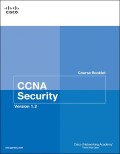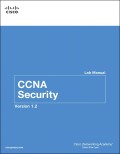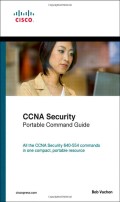| Course Title: | Cisco Networking Academy – Advanced Network Security with Lab |
|---|---|
| Course Number: | SEC453 |
| Course Description: | This course will be taught in tandem with the Cisco Academy CCNA - Security course shell, from the Cisco Academy website. Students in this course develop more advanced skills in the implementation of common network security techniques. The learner will be able to define common security threats and the mitigation methods needed to prevent them from occurring. The learner will demonstrate network security management by means of centralized authentication methods, logging and reporting network incidents, as well as implementation of policy. The learner will also implement security management by the hardening of the routers and switches that make up the network, as well as network traffic monitoring and prevention by way of IPS and firewall technologies. Finally, the learner will secure communications via implementation of VPN technologies and configurations. Completion of this course will position the student for preparing for the CCNA-Security certification exam if the prerequisite CCNA certification is in hand. |
| Course Prerequisites: | NETW209 / 4-3 |
Syllabus
Course Information
Course Specific Requirements
- The student enrolling in this course will simultaneously be enrolled in the Cisco Academy CCNA-Security course. This dual-enrollment format will be led from DeVry via the eCollege management system, which will address resources on the Cisco Academy course management system—NetSpace.
- The primary resource will be the textbook, which is available in print as well. Another heavily used NetSpace resource is the Packet Tracer simulation application. This, as all other resources, can be downloaded from the NetSpace site.
- The chapter exams will taken from Cisco NetSpace. These will be used as learning tools more than assessments, in that you may take the chapter exams up to five times.
- Due to the advanced nature of some of the course topics, it is important that a pre-reading of the week's material take place. This permits the material to be seen for a second time during class time, and, thus, comprehension should be greatly improved.
- This course helps prepare the student for the 'Implementing Cisco IOS Network Security' (IINS) certification certification exam, #640-554, in pursuit of the CCNA-Security certification. It must be noted, however, that in order to be able to sit for the CCNA-Security exam, you must have current CCNA certification, which is what NETW203-209 is based on.
Software Citation Requirements
This course uses open-source software, and as the end users of this software, students are required to cite the software for any student work, such as assignments, labs, or projects, where the software has been utilized. Open-source software does have end-user license agreements, and all students should read the entire agreement for a software prior to installation or usage. In order to use the software in this course, software citations have been created for students and can be located on the Open Source Applications page. These software citations must be included in all student work submissions that have used the software.
Textbooks and Resources
Required Textbooks
The following books are required for this course:

CCNA Security Course Booklet v1.2
3rd Edition
by Cisco Network Academy
September 26, 2014
This e-book is provided as part of the Cisco Academy dual enrollment. You may access it from the NetSpace SEC453 shell. A hard copy of the text is also available.*

CCNA Security Lab Manual v1.2
3rd Edition
by Cisco Network Academy
September 26, 2014
The labs in this manual are also available from the e-book on NetSpace. The numbers associated with the labs correspond to the location in the chapter of the e-book.
CCNA Security Portable Command Guide
1st Edition, 2nd Printing
by Bob Vachon
2014
This book is NOT provided for you via Cisco Academy. The eBook is here in VitalSource. A hardcopy may be purchased separately.
E-book Details
First Time Using VitalSource? Step 1: View the VitalSource Video Step 2: Register with VitalSource Bookshelf Online
Step 3: Access the Desktop and Mobile Versions | Already Registered? 3 Ways to Access Your eBooks
|
To find out more about VitalSource Bookshelf, check out the VitalSource FAQ.
Physical Books and Supplies
Your course may require additional materials, such as a course kit. Visit the online bookstore if you have not yet ordered your books and supplies.
Campus Additional Information
Enter content here, if necessary.
Terminal Course Objectives
DeVry University course content is constructed from curriculum guides developed for each course that are in alignment with specific Terminal Course Objectives. The Terminal Course Objectives (TCOs) define the learning objectives that the student will be required to comprehend and demonstrate by course completion. The TCOs that will be covered in detail each week can be found in the Objectives section for that particular week. Whenever possible, a reference will be made from a particular assignment or discussion back to the TCO that it emphasizes.
1
Given a large network with Internet access, analyze various internal or external attacks on the network. Describe the attack scenarios and how to deal with each type of attack, such as Denial of Service attacks, Spoofing, Replays, TCP Session Hijacking, and Attacks on Encrypted Data (such as passwords). Demonstrate the ability to better secure the router against such attacks, as well as secured access to the router.
2
Given a medium size network with various IT personnel, create a plan for secure access to the network routers that includes: (1) localized and centralized Encrypted Authentication (2) encrypted communication between the network router and the administrator, and (3) different levels of access-based IT personnel roles..
3
Given a large business network, the student will learn the importance of network traffic control and the implementation of traffic control devices within the network. This includes implementation of firewalls at the network parameter to control traffic from a foreign network, and strategically placed IPS systems throughout the network for added traffic control. Demonstrate how IPS and IOS firewalls are configured and implemented. The student will demonstrate proficiency with both firewalls and IPS by way of lab assignments.
4
Given a medium to large size network, the student will implement a security plan that addresses the security vulnerabilities of Layer 2 switches. The plan should include mitigation of MAC Spoofing, MAC Flooding, STP, and VLAN Hopping attacks.
5
The student will describe how confidentiality, integrity, and authentication (CIA) is enabled through the various security concepts such as pre-shared key versus public-key encryption, and hashing methods for integrity and authentication protocols. The student will describe the different components that make up a Public Key Infrastructure (PKI) and the systems that use PKI, such as SSL communications and IPSec for pre-shared key VPNs.
6
Given a large internetwork of two or more Local Area Networks (LANs) connected to each other via a public medium (such as the Internet), create a detailed plan for the creation of a Virtual Private Network (VPN) to maintain data confidentiality and integrity for protected packets between sites (Site-to-Site VPNs), and from remote clients (Remote Access VPNs).
7
Given a medium to large network, demonstrate your understanding of the Cisco ASA by planning and implementing the firewall to provide firewalling, VPN, and NAT support. Configuration should be implemented using CLI commands, interactive wizards, and GUI administrative tools.
8
Given a large network, the student will understand the principles of a secure network design, using the industry best practices, as well as the more finely developed Cisco Secure X Architecture. In doing so, the soft practices, such as Risk Management, Disaster Recovery, and Business Continuity Planning are intertwined with the hard practices covered in most of the course.
9
Given that the student has completed the study of the entire textbook, he or she will be ready to prepare for the CCNA - Security certification exam.
Lab Schedule
Week 1
Week 2
Week 3
Week 4
Week 5
Week 6
Week 7
Week 8
Course Schedule
| Week, TCOs, and Topics | Readings and Class Preparation | Activities and Assignments |
|---|---|---|
| Week 1 TCO 1 Security Threats and Layered Network Protection | NetSpace Text:
Portable Command Guide (PCG) Reference:
| In-Class Lab At-Home Lab Homework: Chapter 1 Study Guide Graded Discussion Topic Chapter Exam |
| Week 2 TCO 2 Router Security and AAA | NetSpace Text:
PCG Reference:
| In-Class Lab At-Home Lab Homework: Chapter 2 & 3 Study Guides Graded Discussion Topic Chapter Exam |
| Week 3 TCO 3 ISR Firewalls and IPS | NetSpace Text:
PCG Reference:
| In-Class Lab At-Home Lab Homework: Chapters 4 & 5 Study Guides Graded Discussion Topic Chapter Exam |
| Week 4 TCOs 4 & 5 SwitChapter Security | NetSpace Text:
PCG Reference:
| In-Class Lab: At-Home Lab: Homework: Chapter 6 Study Guide Graded Discussion Topic |
| Week 5 TCOs 5 & 6 Cryptography and VPNs | NetSpace Text:
PCG Reference:
| In-Class Lab: At-Home Lab: Homework: Chapters 7 & 8 Study Guides Graded Discussion Topic Chapter Exam |
| Week 6 TCO 7 ASA Firewalls | NetSpace Text:
PCG Reference:
| In-Class Lab: At-Home Lab: Homework: Chapter 9 Study Guide Graded Discussion Topic |
| Week 7 TCOs 8 & 9 Security Management and CCNA-Security Cert Prep | NetSpace Text:
PCG Reference:
| At-Home Lab: Skills Based Assessment (SBA) In-Class Lab Homework: Chapter 10 Study Guide Graded Discussion Topic |
| Week 8 All TCOs | Final Exam | |
Blended E-Learning
This course is an 8-week, intensive course that includes both classroom-based and e-learning activities. Your participation in both areas is essential to your success in this course. You should expect to spend time each week participating in the prescribed activities both before and after our class meeting.
Participation before, during, and after class meetings is critical to your success in this intensive environment.
To get the most out of our weekly class meetings, it is essential that you come to class prepared. The weekly readings listed in the Course Schedule will prepare you for class. Our class meetings, in turn, will prepare you for upcoming exams and assignments.
Through the DeVry e-learning platform, you will be able to
- review the Syllabus and weekly assignment information;
- submit completed work for grading;
- take quizzes and exams;
- obtain copies of class handouts and notes;
- e-mail the instructor and other students; and
- participate in online discussion of class material.
iConnect Live
This course contains iConnect Live sessions that provide students with the opportunity to attend live presentations, which cover course materials, projects, and assignments. Please see the iConnect Live items for the days and times of the live sessions and for the link to enter each session. You will also receive e-mail reminders each week.
If you are unable to attend the live session, you can watch the recorded session by clicking on the Recordings link that will appear in the iConnect Live item after the lecture has concluded. Please contact your instructor with any questions.
Please note that because of unavoidable technological issues and presenter availability, the live lectures may be substituted with prerecorded lectures.
Due Dates for Assignments & Exams
Unless otherwise specified, the following applies.
- Access to most weeks begins on Sunday at 12:01 a.m. mountain time (MT).
- All assignments are to be submitted on or before Sunday at the end of the specified week that they are due, by 11:59 p.m. (MT).
- All quizzes and exams are to be completed on or before Sunday at the end of the specified week that they open, by 11:59 p.m. (MT).
Week 8 opens at 12:01 a.m. (MT) on the ending Sunday of Week 7. Any assignments or exams must be completed by 11:59 p.m. (MT) Saturday of the eighth week.
Due Dates for Assignments & Exams
All assignments, quizzes, and exams are to be completed per the schedule indicated by your instructor.
Assignment Values and Letter Grades
The maximum score in this class is 3,900 points. The categories, which contribute to your final grade, are weighted as follows.
| Assignment | Points | Weighting |
|---|---|---|
| Discussions (Weeks 1–7) | 700 | 14% |
| At-Home Lab (Weeks 1-6) | 600 | 14% |
| In-Class Lab (Weeks 1-7) | 700 | 14% |
| Chapter Exams (Weeks 1-7, one or two exams per week) | 1000 | 20% |
| Homework (Weeks 1-7) | 700 | 14% |
| Final Exam | 100 | 12% |
| Skills Based Assessment (Week 7) | 100 | 12% |
| Total Points | 3,900 | 100% |
All of your course requirements are graded using points. At the end of the course, the points are converted to a letter grade using the scale in the table below.
| Letter Grade | Points | Percentage |
|---|---|---|
| A | 900–1,000 | 90% to 100% |
| B | 800–899 | 80% to 89% |
| C | 700–799 | 70% to 79% |
| D | 600–699 | 60% to 69% |
| F | 599 and below | Below 60% |
DeVry Graduate Academic Policy and Relevant Resources
DeVry Undergraduate Academic Policy and Relevant Resources
Frequently Asked Questions
When are grades calculated, and how can I view my grades?
- You must complete any quizzes and post your written assignments (if necessary) to the weekly Dropbox by Sunday 11:59 p.m. (MT) each week, except Week 8 which closes at 11:59 p.m. (MT) Saturday.
- Once your work is reviewed, you should see comments and total points for each assignment in the Gradebook. Instructors should have Discussion work graded by the following Tuesday and all other assignments by the following Friday.
- You may check your progress at any time by going to the Gradebook, selecting the week and then your name.
- Click on the points earned for each assignment in the Gradebook to see any instructor comments.
What should I do if a discrepancy is found with my grade?
- Double-check the error and try to determine what caused it.
- Send your instructor an email explaining your findings.
- Trust that any error in grading will be corrected quickly
What if I cannot get my work submitted on time?
- If you have an emergency that will cause your work to be late, please contact your instructor in advance of the due date so that arrangements can be made. Your instructor may reserve the right to deduct points for work turned in late based on the reason and the timeliness of notice.
- If a technical problem prevents you from meeting the scheduled due date, please contact the Help Desk at 1-800-594-2402 and immediately email your instructor about the situation.
How can I get extra credit?
Extra credit is not an option.
Questions and Concerns
Please feel free to contact me for help with coursework or other areas that may impact your progress. Here are some examples.
- Do you have general questions about attendance, deadlines regarding your courses, student financial aid, or other areas?
- Are you a member of the military service? Do you need to adjust your schedule due to active duty, or do you have questions about your GI Bill® benefits or have other unforeseen military and veteran-related issues that have developed?
- Do you need supplementary student assistance? Please let me know if you are having academic difficulty and would like an ADA accommodation. Although I can talk with you about getting assistance, an excellent point of contact is the Office of Student Disability Services. You can reach the Office by calling 877-496-9050, option 3, or by e-mailing adaofficer@devry.edu or adaofficer@keller.edu.
Regardless of your situation, please feel free to contact me for assistance in whatever area of concern you might have. I will do everything I can to assist you or put you in contact with University colleagues who are trained to assist you in whatever area of concern you might have.
"GI Bill® is a registered trademark of the U.S. Department of Veterans Affairs (VA). More information about education benefits offered by the VA is available at the official U.S. government website: www.benefits.va.gov/gibill.”



